Human Factors in Aviation: Kegworth Accident and Stakeholder Impact
VerifiedAdded on 2022/11/29
|10
|3813
|236
Report
AI Summary
This report provides a comprehensive analysis of human factors in aviation, using the 1989 Kegworth air disaster as a case study. It explores the consequences of human errors, including premature responses to engine problems, misidentification of faulty engines, and inadequate information regarding the fracture surface of a fan blade. The report details the impact of these factors on various stakeholders, such as British Midland Airways, Boeing, and the crew union. It examines the airline's operational procedures, the aircraft manufacturer's design considerations, and the crew's responses during the emergency. The report also provides recommendations for improving aviation safety, including enhanced crew training, improved aircraft design to mitigate injury, and better protection of fuel tanks. This report underscores the critical importance of understanding and managing human factors to prevent future aviation accidents.
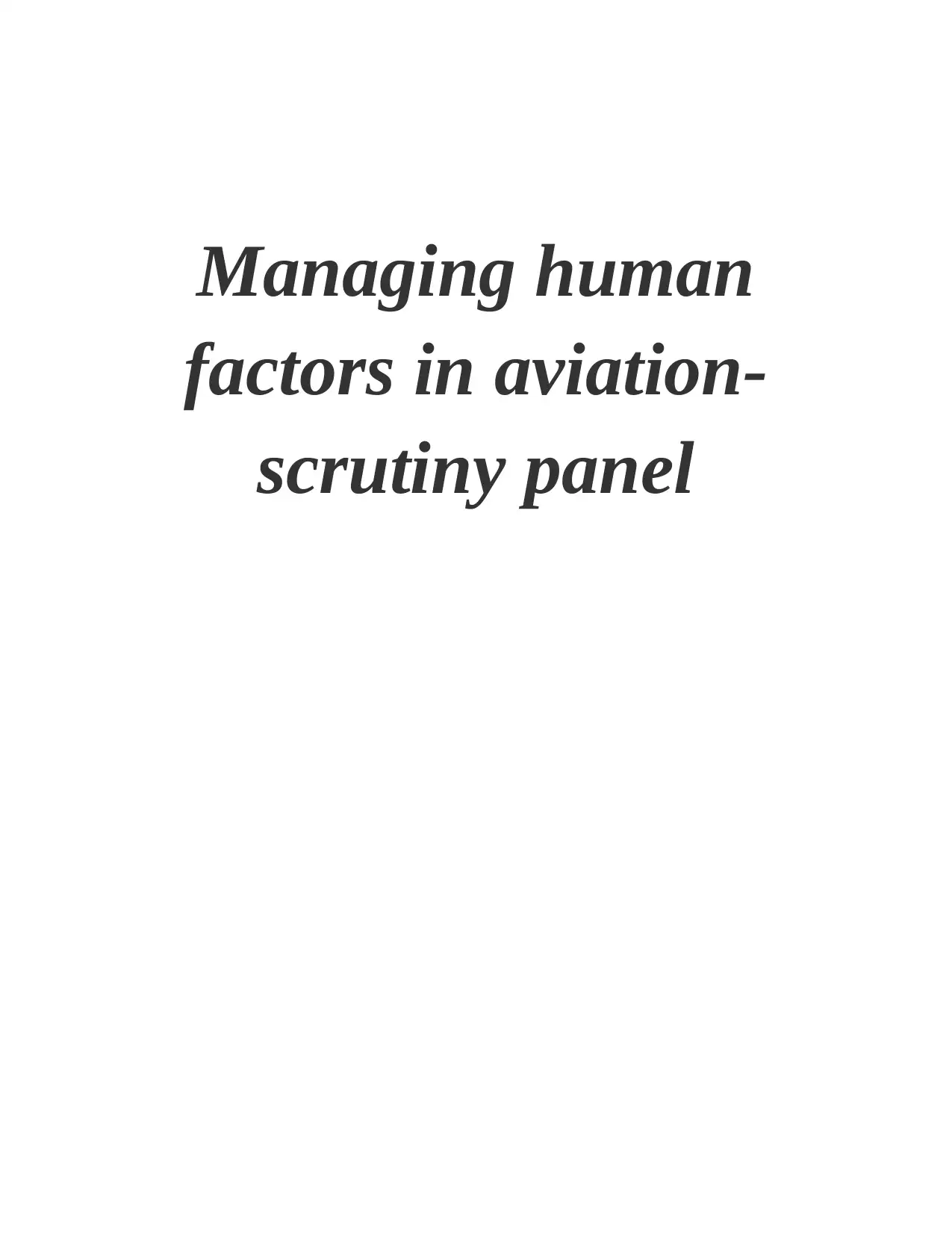
Managing human
factors in aviation-
scrutiny panel
factors in aviation-
scrutiny panel
Paraphrase This Document
Need a fresh take? Get an instant paraphrase of this document with our AI Paraphraser
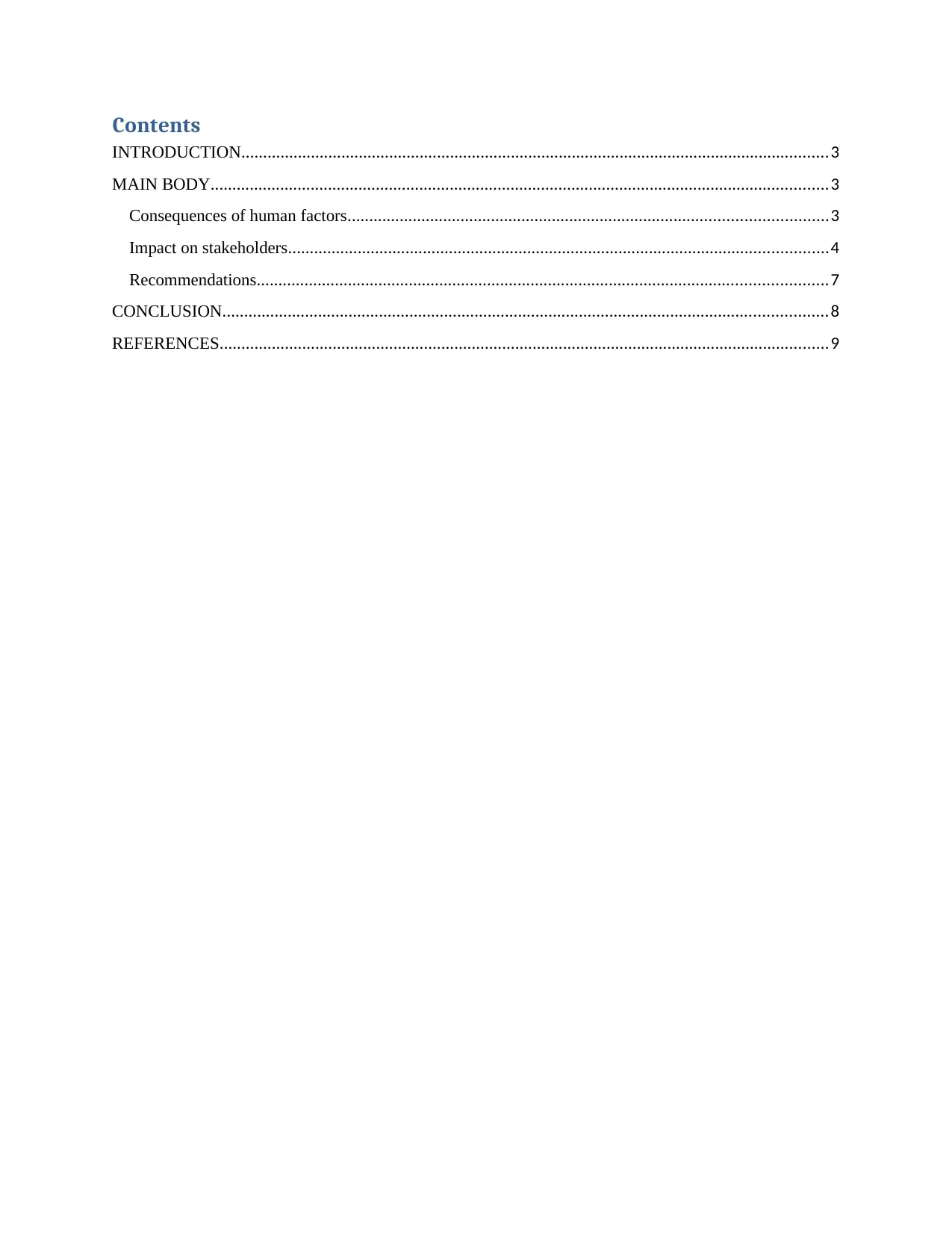
Contents
INTRODUCTION.......................................................................................................................................3
MAIN BODY..............................................................................................................................................3
Consequences of human factors..............................................................................................................3
Impact on stakeholders............................................................................................................................4
Recommendations...................................................................................................................................7
CONCLUSION...........................................................................................................................................8
REFERENCES............................................................................................................................................9
INTRODUCTION.......................................................................................................................................3
MAIN BODY..............................................................................................................................................3
Consequences of human factors..............................................................................................................3
Impact on stakeholders............................................................................................................................4
Recommendations...................................................................................................................................7
CONCLUSION...........................................................................................................................................8
REFERENCES............................................................................................................................................9
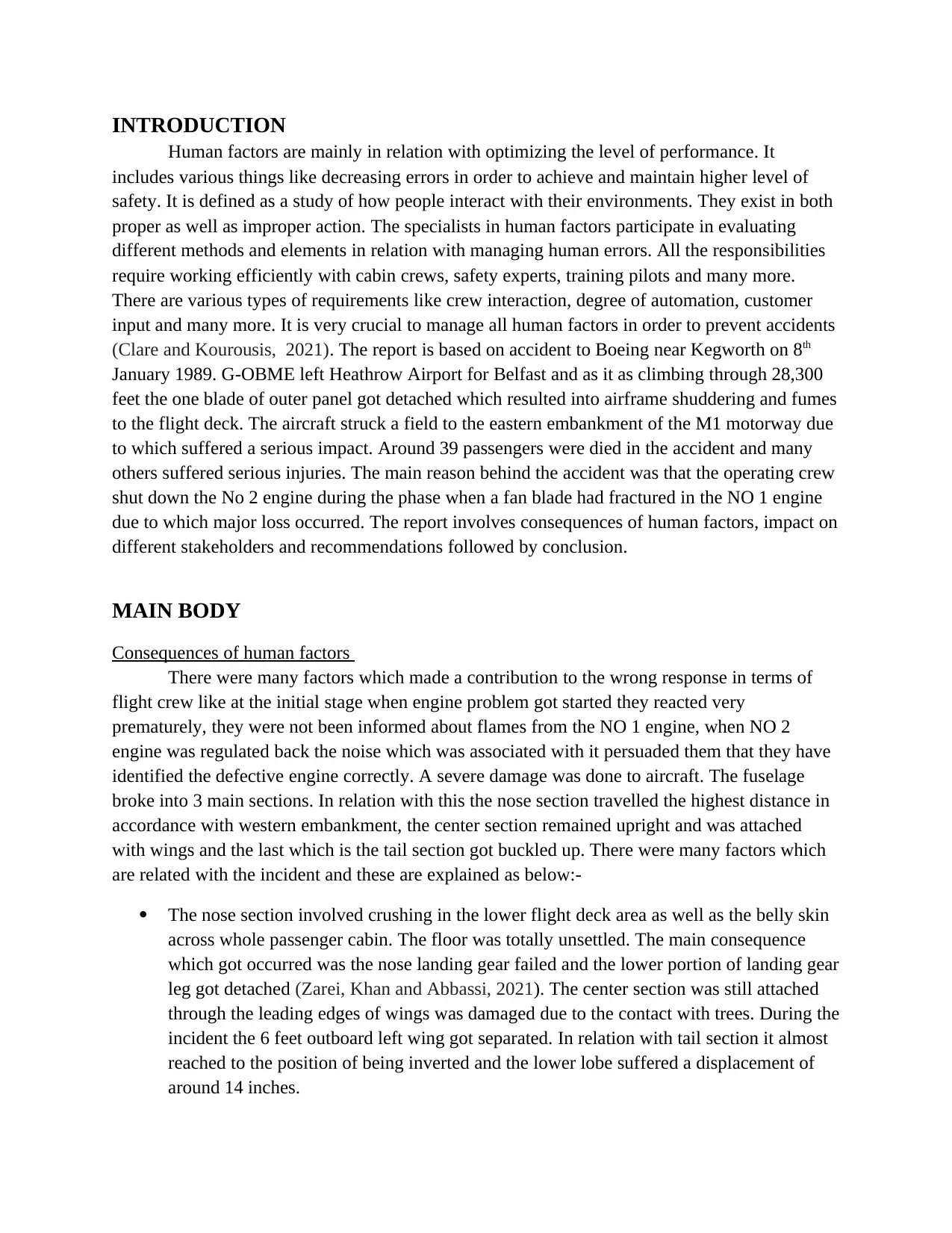
INTRODUCTION
Human factors are mainly in relation with optimizing the level of performance. It
includes various things like decreasing errors in order to achieve and maintain higher level of
safety. It is defined as a study of how people interact with their environments. They exist in both
proper as well as improper action. The specialists in human factors participate in evaluating
different methods and elements in relation with managing human errors. All the responsibilities
require working efficiently with cabin crews, safety experts, training pilots and many more.
There are various types of requirements like crew interaction, degree of automation, customer
input and many more. It is very crucial to manage all human factors in order to prevent accidents
(Clare and Kourousis, 2021). The report is based on accident to Boeing near Kegworth on 8th
January 1989. G-OBME left Heathrow Airport for Belfast and as it as climbing through 28,300
feet the one blade of outer panel got detached which resulted into airframe shuddering and fumes
to the flight deck. The aircraft struck a field to the eastern embankment of the M1 motorway due
to which suffered a serious impact. Around 39 passengers were died in the accident and many
others suffered serious injuries. The main reason behind the accident was that the operating crew
shut down the No 2 engine during the phase when a fan blade had fractured in the NO 1 engine
due to which major loss occurred. The report involves consequences of human factors, impact on
different stakeholders and recommendations followed by conclusion.
MAIN BODY
Consequences of human factors
There were many factors which made a contribution to the wrong response in terms of
flight crew like at the initial stage when engine problem got started they reacted very
prematurely, they were not been informed about flames from the NO 1 engine, when NO 2
engine was regulated back the noise which was associated with it persuaded them that they have
identified the defective engine correctly. A severe damage was done to aircraft. The fuselage
broke into 3 main sections. In relation with this the nose section travelled the highest distance in
accordance with western embankment, the center section remained upright and was attached
with wings and the last which is the tail section got buckled up. There were many factors which
are related with the incident and these are explained as below:-
The nose section involved crushing in the lower flight deck area as well as the belly skin
across whole passenger cabin. The floor was totally unsettled. The main consequence
which got occurred was the nose landing gear failed and the lower portion of landing gear
leg got detached (Zarei, Khan and Abbassi, 2021). The center section was still attached
through the leading edges of wings was damaged due to the contact with trees. During the
incident the 6 feet outboard left wing got separated. In relation with tail section it almost
reached to the position of being inverted and the lower lobe suffered a displacement of
around 14 inches.
Human factors are mainly in relation with optimizing the level of performance. It
includes various things like decreasing errors in order to achieve and maintain higher level of
safety. It is defined as a study of how people interact with their environments. They exist in both
proper as well as improper action. The specialists in human factors participate in evaluating
different methods and elements in relation with managing human errors. All the responsibilities
require working efficiently with cabin crews, safety experts, training pilots and many more.
There are various types of requirements like crew interaction, degree of automation, customer
input and many more. It is very crucial to manage all human factors in order to prevent accidents
(Clare and Kourousis, 2021). The report is based on accident to Boeing near Kegworth on 8th
January 1989. G-OBME left Heathrow Airport for Belfast and as it as climbing through 28,300
feet the one blade of outer panel got detached which resulted into airframe shuddering and fumes
to the flight deck. The aircraft struck a field to the eastern embankment of the M1 motorway due
to which suffered a serious impact. Around 39 passengers were died in the accident and many
others suffered serious injuries. The main reason behind the accident was that the operating crew
shut down the No 2 engine during the phase when a fan blade had fractured in the NO 1 engine
due to which major loss occurred. The report involves consequences of human factors, impact on
different stakeholders and recommendations followed by conclusion.
MAIN BODY
Consequences of human factors
There were many factors which made a contribution to the wrong response in terms of
flight crew like at the initial stage when engine problem got started they reacted very
prematurely, they were not been informed about flames from the NO 1 engine, when NO 2
engine was regulated back the noise which was associated with it persuaded them that they have
identified the defective engine correctly. A severe damage was done to aircraft. The fuselage
broke into 3 main sections. In relation with this the nose section travelled the highest distance in
accordance with western embankment, the center section remained upright and was attached
with wings and the last which is the tail section got buckled up. There were many factors which
are related with the incident and these are explained as below:-
The nose section involved crushing in the lower flight deck area as well as the belly skin
across whole passenger cabin. The floor was totally unsettled. The main consequence
which got occurred was the nose landing gear failed and the lower portion of landing gear
leg got detached (Zarei, Khan and Abbassi, 2021). The center section was still attached
through the leading edges of wings was damaged due to the contact with trees. During the
incident the 6 feet outboard left wing got separated. In relation with tail section it almost
reached to the position of being inverted and the lower lobe suffered a displacement of
around 14 inches.
⊘ This is a preview!⊘
Do you want full access?
Subscribe today to unlock all pages.

Trusted by 1+ million students worldwide
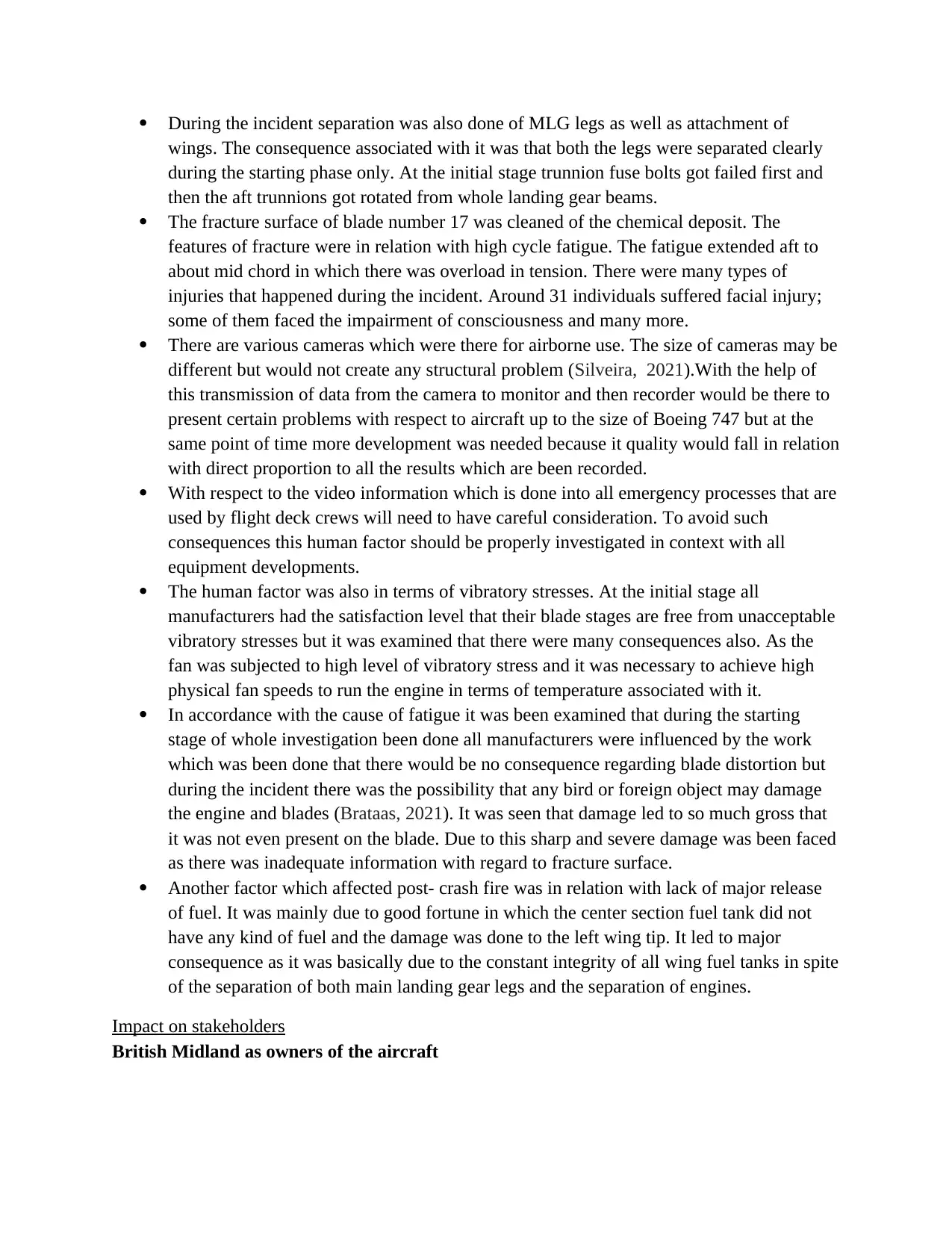
During the incident separation was also done of MLG legs as well as attachment of
wings. The consequence associated with it was that both the legs were separated clearly
during the starting phase only. At the initial stage trunnion fuse bolts got failed first and
then the aft trunnions got rotated from whole landing gear beams.
The fracture surface of blade number 17 was cleaned of the chemical deposit. The
features of fracture were in relation with high cycle fatigue. The fatigue extended aft to
about mid chord in which there was overload in tension. There were many types of
injuries that happened during the incident. Around 31 individuals suffered facial injury;
some of them faced the impairment of consciousness and many more.
There are various cameras which were there for airborne use. The size of cameras may be
different but would not create any structural problem (Silveira, 2021).With the help of
this transmission of data from the camera to monitor and then recorder would be there to
present certain problems with respect to aircraft up to the size of Boeing 747 but at the
same point of time more development was needed because it quality would fall in relation
with direct proportion to all the results which are been recorded.
With respect to the video information which is done into all emergency processes that are
used by flight deck crews will need to have careful consideration. To avoid such
consequences this human factor should be properly investigated in context with all
equipment developments.
The human factor was also in terms of vibratory stresses. At the initial stage all
manufacturers had the satisfaction level that their blade stages are free from unacceptable
vibratory stresses but it was examined that there were many consequences also. As the
fan was subjected to high level of vibratory stress and it was necessary to achieve high
physical fan speeds to run the engine in terms of temperature associated with it.
In accordance with the cause of fatigue it was been examined that during the starting
stage of whole investigation been done all manufacturers were influenced by the work
which was been done that there would be no consequence regarding blade distortion but
during the incident there was the possibility that any bird or foreign object may damage
the engine and blades (Brataas, 2021). It was seen that damage led to so much gross that
it was not even present on the blade. Due to this sharp and severe damage was been faced
as there was inadequate information with regard to fracture surface.
Another factor which affected post- crash fire was in relation with lack of major release
of fuel. It was mainly due to good fortune in which the center section fuel tank did not
have any kind of fuel and the damage was done to the left wing tip. It led to major
consequence as it was basically due to the constant integrity of all wing fuel tanks in spite
of the separation of both main landing gear legs and the separation of engines.
Impact on stakeholders
British Midland as owners of the aircraft
wings. The consequence associated with it was that both the legs were separated clearly
during the starting phase only. At the initial stage trunnion fuse bolts got failed first and
then the aft trunnions got rotated from whole landing gear beams.
The fracture surface of blade number 17 was cleaned of the chemical deposit. The
features of fracture were in relation with high cycle fatigue. The fatigue extended aft to
about mid chord in which there was overload in tension. There were many types of
injuries that happened during the incident. Around 31 individuals suffered facial injury;
some of them faced the impairment of consciousness and many more.
There are various cameras which were there for airborne use. The size of cameras may be
different but would not create any structural problem (Silveira, 2021).With the help of
this transmission of data from the camera to monitor and then recorder would be there to
present certain problems with respect to aircraft up to the size of Boeing 747 but at the
same point of time more development was needed because it quality would fall in relation
with direct proportion to all the results which are been recorded.
With respect to the video information which is done into all emergency processes that are
used by flight deck crews will need to have careful consideration. To avoid such
consequences this human factor should be properly investigated in context with all
equipment developments.
The human factor was also in terms of vibratory stresses. At the initial stage all
manufacturers had the satisfaction level that their blade stages are free from unacceptable
vibratory stresses but it was examined that there were many consequences also. As the
fan was subjected to high level of vibratory stress and it was necessary to achieve high
physical fan speeds to run the engine in terms of temperature associated with it.
In accordance with the cause of fatigue it was been examined that during the starting
stage of whole investigation been done all manufacturers were influenced by the work
which was been done that there would be no consequence regarding blade distortion but
during the incident there was the possibility that any bird or foreign object may damage
the engine and blades (Brataas, 2021). It was seen that damage led to so much gross that
it was not even present on the blade. Due to this sharp and severe damage was been faced
as there was inadequate information with regard to fracture surface.
Another factor which affected post- crash fire was in relation with lack of major release
of fuel. It was mainly due to good fortune in which the center section fuel tank did not
have any kind of fuel and the damage was done to the left wing tip. It led to major
consequence as it was basically due to the constant integrity of all wing fuel tanks in spite
of the separation of both main landing gear legs and the separation of engines.
Impact on stakeholders
British Midland as owners of the aircraft
Paraphrase This Document
Need a fresh take? Get an instant paraphrase of this document with our AI Paraphraser
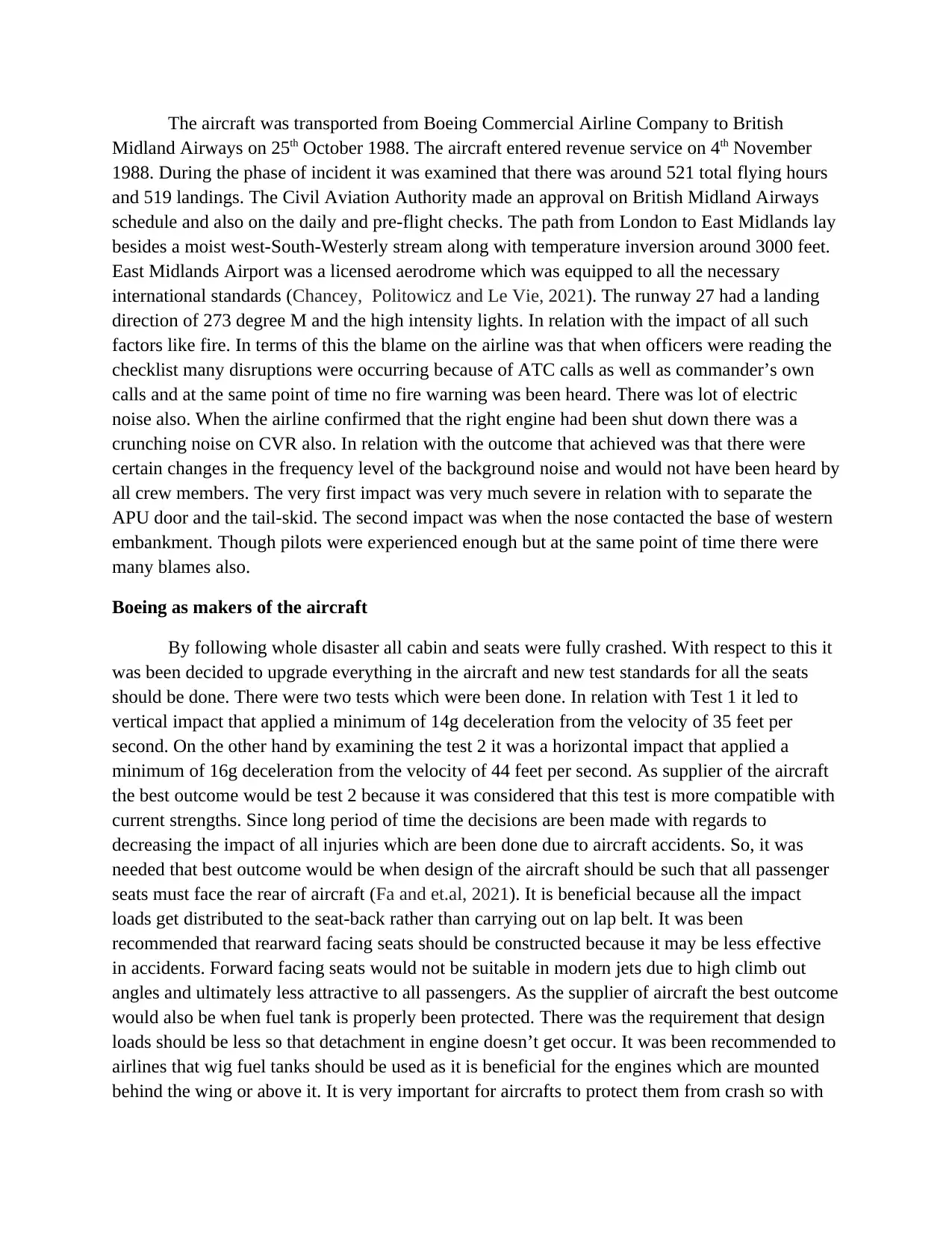
The aircraft was transported from Boeing Commercial Airline Company to British
Midland Airways on 25th October 1988. The aircraft entered revenue service on 4th November
1988. During the phase of incident it was examined that there was around 521 total flying hours
and 519 landings. The Civil Aviation Authority made an approval on British Midland Airways
schedule and also on the daily and pre-flight checks. The path from London to East Midlands lay
besides a moist west-South-Westerly stream along with temperature inversion around 3000 feet.
East Midlands Airport was a licensed aerodrome which was equipped to all the necessary
international standards (Chancey, Politowicz and Le Vie, 2021). The runway 27 had a landing
direction of 273 degree M and the high intensity lights. In relation with the impact of all such
factors like fire. In terms of this the blame on the airline was that when officers were reading the
checklist many disruptions were occurring because of ATC calls as well as commander’s own
calls and at the same point of time no fire warning was been heard. There was lot of electric
noise also. When the airline confirmed that the right engine had been shut down there was a
crunching noise on CVR also. In relation with the outcome that achieved was that there were
certain changes in the frequency level of the background noise and would not have been heard by
all crew members. The very first impact was very much severe in relation with to separate the
APU door and the tail-skid. The second impact was when the nose contacted the base of western
embankment. Though pilots were experienced enough but at the same point of time there were
many blames also.
Boeing as makers of the aircraft
By following whole disaster all cabin and seats were fully crashed. With respect to this it
was been decided to upgrade everything in the aircraft and new test standards for all the seats
should be done. There were two tests which were been done. In relation with Test 1 it led to
vertical impact that applied a minimum of 14g deceleration from the velocity of 35 feet per
second. On the other hand by examining the test 2 it was a horizontal impact that applied a
minimum of 16g deceleration from the velocity of 44 feet per second. As supplier of the aircraft
the best outcome would be test 2 because it was considered that this test is more compatible with
current strengths. Since long period of time the decisions are been made with regards to
decreasing the impact of all injuries which are been done due to aircraft accidents. So, it was
needed that best outcome would be when design of the aircraft should be such that all passenger
seats must face the rear of aircraft (Fa and et.al, 2021). It is beneficial because all the impact
loads get distributed to the seat-back rather than carrying out on lap belt. It was been
recommended that rearward facing seats should be constructed because it may be less effective
in accidents. Forward facing seats would not be suitable in modern jets due to high climb out
angles and ultimately less attractive to all passengers. As the supplier of aircraft the best outcome
would also be when fuel tank is properly been protected. There was the requirement that design
loads should be less so that detachment in engine doesn’t get occur. It was been recommended to
airlines that wig fuel tanks should be used as it is beneficial for the engines which are mounted
behind the wing or above it. It is very important for aircrafts to protect them from crash so with
Midland Airways on 25th October 1988. The aircraft entered revenue service on 4th November
1988. During the phase of incident it was examined that there was around 521 total flying hours
and 519 landings. The Civil Aviation Authority made an approval on British Midland Airways
schedule and also on the daily and pre-flight checks. The path from London to East Midlands lay
besides a moist west-South-Westerly stream along with temperature inversion around 3000 feet.
East Midlands Airport was a licensed aerodrome which was equipped to all the necessary
international standards (Chancey, Politowicz and Le Vie, 2021). The runway 27 had a landing
direction of 273 degree M and the high intensity lights. In relation with the impact of all such
factors like fire. In terms of this the blame on the airline was that when officers were reading the
checklist many disruptions were occurring because of ATC calls as well as commander’s own
calls and at the same point of time no fire warning was been heard. There was lot of electric
noise also. When the airline confirmed that the right engine had been shut down there was a
crunching noise on CVR also. In relation with the outcome that achieved was that there were
certain changes in the frequency level of the background noise and would not have been heard by
all crew members. The very first impact was very much severe in relation with to separate the
APU door and the tail-skid. The second impact was when the nose contacted the base of western
embankment. Though pilots were experienced enough but at the same point of time there were
many blames also.
Boeing as makers of the aircraft
By following whole disaster all cabin and seats were fully crashed. With respect to this it
was been decided to upgrade everything in the aircraft and new test standards for all the seats
should be done. There were two tests which were been done. In relation with Test 1 it led to
vertical impact that applied a minimum of 14g deceleration from the velocity of 35 feet per
second. On the other hand by examining the test 2 it was a horizontal impact that applied a
minimum of 16g deceleration from the velocity of 44 feet per second. As supplier of the aircraft
the best outcome would be test 2 because it was considered that this test is more compatible with
current strengths. Since long period of time the decisions are been made with regards to
decreasing the impact of all injuries which are been done due to aircraft accidents. So, it was
needed that best outcome would be when design of the aircraft should be such that all passenger
seats must face the rear of aircraft (Fa and et.al, 2021). It is beneficial because all the impact
loads get distributed to the seat-back rather than carrying out on lap belt. It was been
recommended that rearward facing seats should be constructed because it may be less effective
in accidents. Forward facing seats would not be suitable in modern jets due to high climb out
angles and ultimately less attractive to all passengers. As the supplier of aircraft the best outcome
would also be when fuel tank is properly been protected. There was the requirement that design
loads should be less so that detachment in engine doesn’t get occur. It was been recommended to
airlines that wig fuel tanks should be used as it is beneficial for the engines which are mounted
behind the wing or above it. It is very important for aircrafts to protect them from crash so with
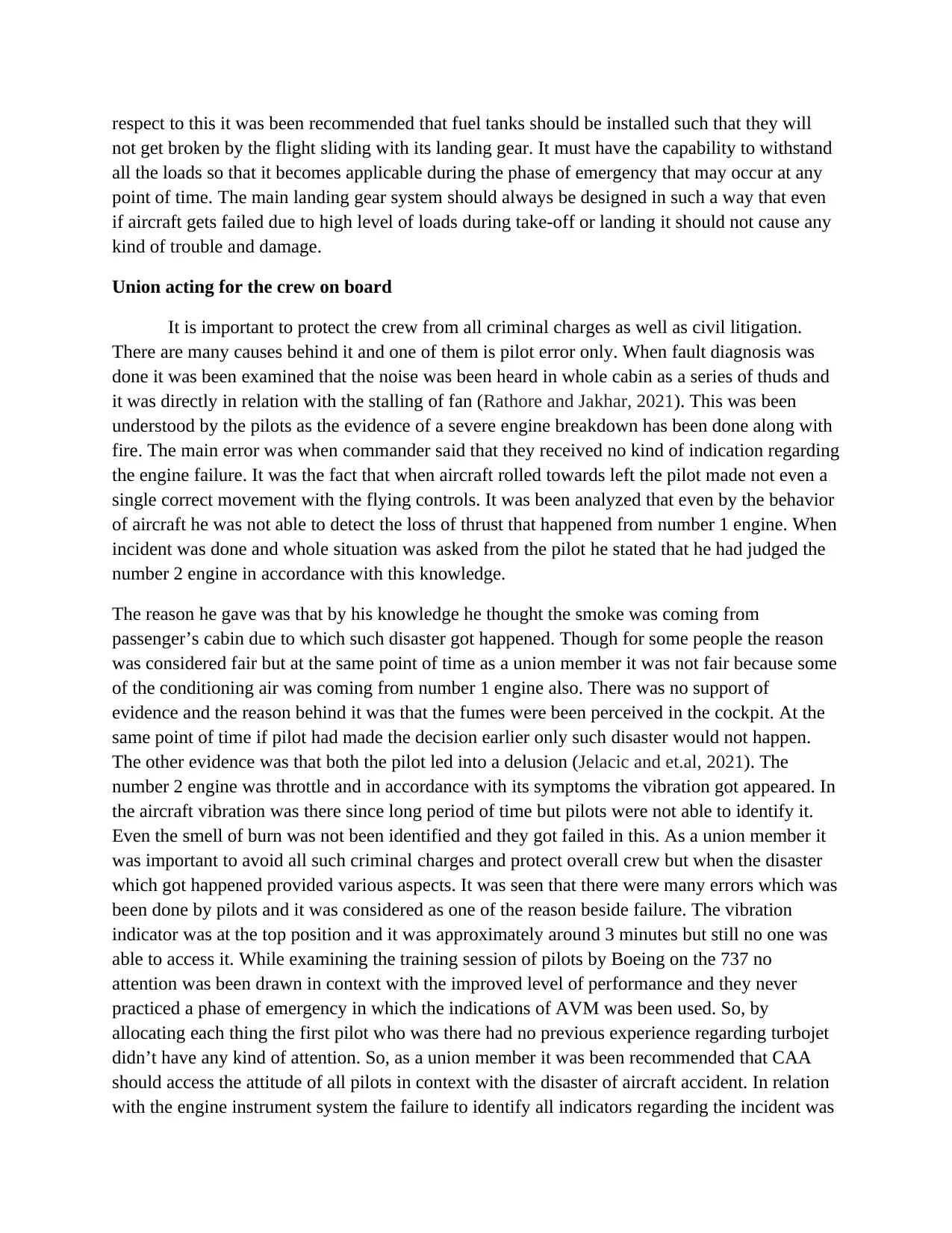
respect to this it was been recommended that fuel tanks should be installed such that they will
not get broken by the flight sliding with its landing gear. It must have the capability to withstand
all the loads so that it becomes applicable during the phase of emergency that may occur at any
point of time. The main landing gear system should always be designed in such a way that even
if aircraft gets failed due to high level of loads during take-off or landing it should not cause any
kind of trouble and damage.
Union acting for the crew on board
It is important to protect the crew from all criminal charges as well as civil litigation.
There are many causes behind it and one of them is pilot error only. When fault diagnosis was
done it was been examined that the noise was been heard in whole cabin as a series of thuds and
it was directly in relation with the stalling of fan (Rathore and Jakhar, 2021). This was been
understood by the pilots as the evidence of a severe engine breakdown has been done along with
fire. The main error was when commander said that they received no kind of indication regarding
the engine failure. It was the fact that when aircraft rolled towards left the pilot made not even a
single correct movement with the flying controls. It was been analyzed that even by the behavior
of aircraft he was not able to detect the loss of thrust that happened from number 1 engine. When
incident was done and whole situation was asked from the pilot he stated that he had judged the
number 2 engine in accordance with this knowledge.
The reason he gave was that by his knowledge he thought the smoke was coming from
passenger’s cabin due to which such disaster got happened. Though for some people the reason
was considered fair but at the same point of time as a union member it was not fair because some
of the conditioning air was coming from number 1 engine also. There was no support of
evidence and the reason behind it was that the fumes were been perceived in the cockpit. At the
same point of time if pilot had made the decision earlier only such disaster would not happen.
The other evidence was that both the pilot led into a delusion (Jelacic and et.al, 2021). The
number 2 engine was throttle and in accordance with its symptoms the vibration got appeared. In
the aircraft vibration was there since long period of time but pilots were not able to identify it.
Even the smell of burn was not been identified and they got failed in this. As a union member it
was important to avoid all such criminal charges and protect overall crew but when the disaster
which got happened provided various aspects. It was seen that there were many errors which was
been done by pilots and it was considered as one of the reason beside failure. The vibration
indicator was at the top position and it was approximately around 3 minutes but still no one was
able to access it. While examining the training session of pilots by Boeing on the 737 no
attention was been drawn in context with the improved level of performance and they never
practiced a phase of emergency in which the indications of AVM was been used. So, by
allocating each thing the first pilot who was there had no previous experience regarding turbojet
didn’t have any kind of attention. So, as a union member it was been recommended that CAA
should access the attitude of all pilots in context with the disaster of aircraft accident. In relation
with the engine instrument system the failure to identify all indicators regarding the incident was
not get broken by the flight sliding with its landing gear. It must have the capability to withstand
all the loads so that it becomes applicable during the phase of emergency that may occur at any
point of time. The main landing gear system should always be designed in such a way that even
if aircraft gets failed due to high level of loads during take-off or landing it should not cause any
kind of trouble and damage.
Union acting for the crew on board
It is important to protect the crew from all criminal charges as well as civil litigation.
There are many causes behind it and one of them is pilot error only. When fault diagnosis was
done it was been examined that the noise was been heard in whole cabin as a series of thuds and
it was directly in relation with the stalling of fan (Rathore and Jakhar, 2021). This was been
understood by the pilots as the evidence of a severe engine breakdown has been done along with
fire. The main error was when commander said that they received no kind of indication regarding
the engine failure. It was the fact that when aircraft rolled towards left the pilot made not even a
single correct movement with the flying controls. It was been analyzed that even by the behavior
of aircraft he was not able to detect the loss of thrust that happened from number 1 engine. When
incident was done and whole situation was asked from the pilot he stated that he had judged the
number 2 engine in accordance with this knowledge.
The reason he gave was that by his knowledge he thought the smoke was coming from
passenger’s cabin due to which such disaster got happened. Though for some people the reason
was considered fair but at the same point of time as a union member it was not fair because some
of the conditioning air was coming from number 1 engine also. There was no support of
evidence and the reason behind it was that the fumes were been perceived in the cockpit. At the
same point of time if pilot had made the decision earlier only such disaster would not happen.
The other evidence was that both the pilot led into a delusion (Jelacic and et.al, 2021). The
number 2 engine was throttle and in accordance with its symptoms the vibration got appeared. In
the aircraft vibration was there since long period of time but pilots were not able to identify it.
Even the smell of burn was not been identified and they got failed in this. As a union member it
was important to avoid all such criminal charges and protect overall crew but when the disaster
which got happened provided various aspects. It was seen that there were many errors which was
been done by pilots and it was considered as one of the reason beside failure. The vibration
indicator was at the top position and it was approximately around 3 minutes but still no one was
able to access it. While examining the training session of pilots by Boeing on the 737 no
attention was been drawn in context with the improved level of performance and they never
practiced a phase of emergency in which the indications of AVM was been used. So, by
allocating each thing the first pilot who was there had no previous experience regarding turbojet
didn’t have any kind of attention. So, as a union member it was been recommended that CAA
should access the attitude of all pilots in context with the disaster of aircraft accident. In relation
with the engine instrument system the failure to identify all indicators regarding the incident was
⊘ This is a preview!⊘
Do you want full access?
Subscribe today to unlock all pages.

Trusted by 1+ million students worldwide
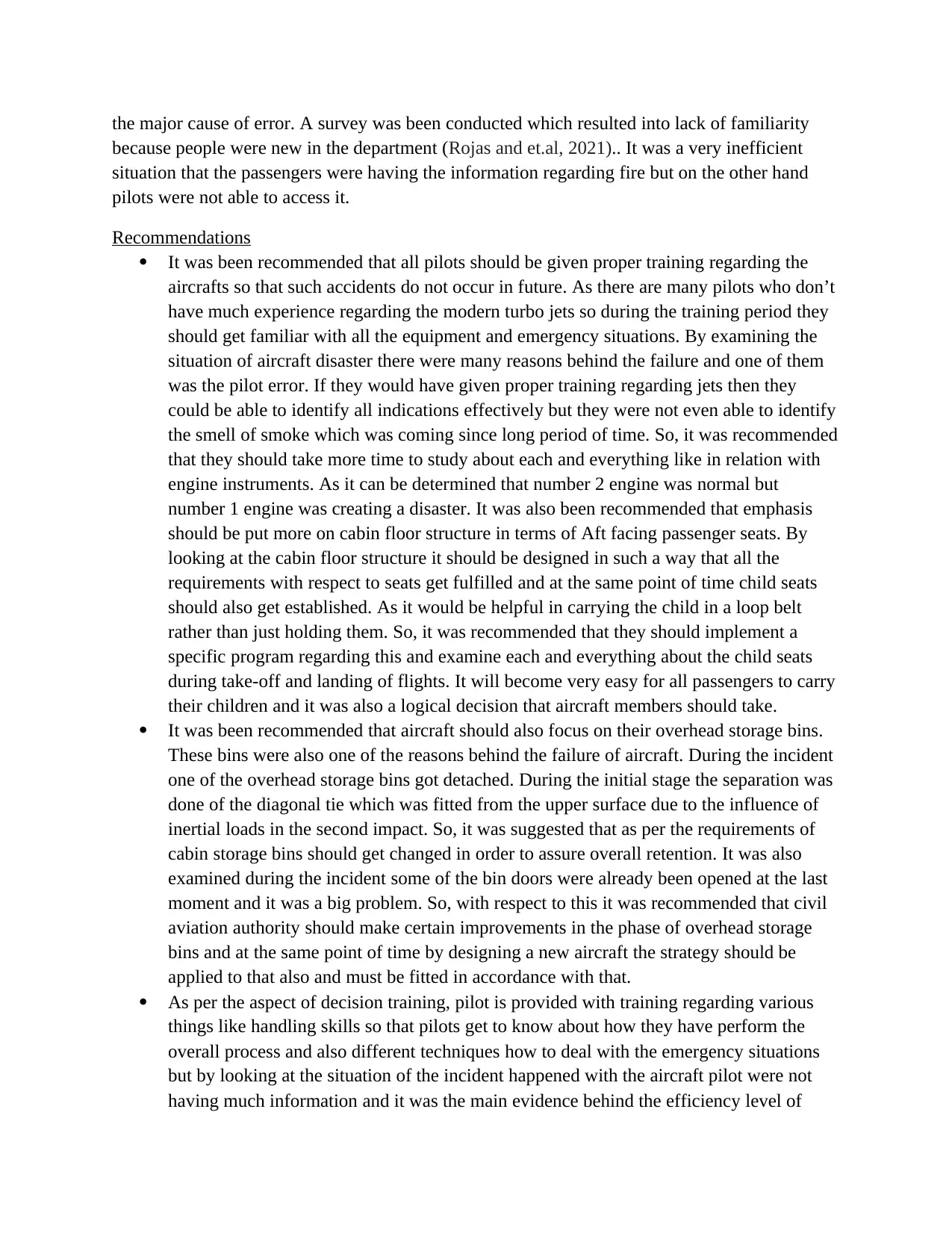
the major cause of error. A survey was been conducted which resulted into lack of familiarity
because people were new in the department (Rojas and et.al, 2021).. It was a very inefficient
situation that the passengers were having the information regarding fire but on the other hand
pilots were not able to access it.
Recommendations
It was been recommended that all pilots should be given proper training regarding the
aircrafts so that such accidents do not occur in future. As there are many pilots who don’t
have much experience regarding the modern turbo jets so during the training period they
should get familiar with all the equipment and emergency situations. By examining the
situation of aircraft disaster there were many reasons behind the failure and one of them
was the pilot error. If they would have given proper training regarding jets then they
could be able to identify all indications effectively but they were not even able to identify
the smell of smoke which was coming since long period of time. So, it was recommended
that they should take more time to study about each and everything like in relation with
engine instruments. As it can be determined that number 2 engine was normal but
number 1 engine was creating a disaster. It was also been recommended that emphasis
should be put more on cabin floor structure in terms of Aft facing passenger seats. By
looking at the cabin floor structure it should be designed in such a way that all the
requirements with respect to seats get fulfilled and at the same point of time child seats
should also get established. As it would be helpful in carrying the child in a loop belt
rather than just holding them. So, it was recommended that they should implement a
specific program regarding this and examine each and everything about the child seats
during take-off and landing of flights. It will become very easy for all passengers to carry
their children and it was also a logical decision that aircraft members should take.
It was been recommended that aircraft should also focus on their overhead storage bins.
These bins were also one of the reasons behind the failure of aircraft. During the incident
one of the overhead storage bins got detached. During the initial stage the separation was
done of the diagonal tie which was fitted from the upper surface due to the influence of
inertial loads in the second impact. So, it was suggested that as per the requirements of
cabin storage bins should get changed in order to assure overall retention. It was also
examined during the incident some of the bin doors were already been opened at the last
moment and it was a big problem. So, with respect to this it was recommended that civil
aviation authority should make certain improvements in the phase of overhead storage
bins and at the same point of time by designing a new aircraft the strategy should be
applied to that also and must be fitted in accordance with that.
As per the aspect of decision training, pilot is provided with training regarding various
things like handling skills so that pilots get to know about how they have perform the
overall process and also different techniques how to deal with the emergency situations
but by looking at the situation of the incident happened with the aircraft pilot were not
having much information and it was the main evidence behind the efficiency level of
because people were new in the department (Rojas and et.al, 2021).. It was a very inefficient
situation that the passengers were having the information regarding fire but on the other hand
pilots were not able to access it.
Recommendations
It was been recommended that all pilots should be given proper training regarding the
aircrafts so that such accidents do not occur in future. As there are many pilots who don’t
have much experience regarding the modern turbo jets so during the training period they
should get familiar with all the equipment and emergency situations. By examining the
situation of aircraft disaster there were many reasons behind the failure and one of them
was the pilot error. If they would have given proper training regarding jets then they
could be able to identify all indications effectively but they were not even able to identify
the smell of smoke which was coming since long period of time. So, it was recommended
that they should take more time to study about each and everything like in relation with
engine instruments. As it can be determined that number 2 engine was normal but
number 1 engine was creating a disaster. It was also been recommended that emphasis
should be put more on cabin floor structure in terms of Aft facing passenger seats. By
looking at the cabin floor structure it should be designed in such a way that all the
requirements with respect to seats get fulfilled and at the same point of time child seats
should also get established. As it would be helpful in carrying the child in a loop belt
rather than just holding them. So, it was recommended that they should implement a
specific program regarding this and examine each and everything about the child seats
during take-off and landing of flights. It will become very easy for all passengers to carry
their children and it was also a logical decision that aircraft members should take.
It was been recommended that aircraft should also focus on their overhead storage bins.
These bins were also one of the reasons behind the failure of aircraft. During the incident
one of the overhead storage bins got detached. During the initial stage the separation was
done of the diagonal tie which was fitted from the upper surface due to the influence of
inertial loads in the second impact. So, it was suggested that as per the requirements of
cabin storage bins should get changed in order to assure overall retention. It was also
examined during the incident some of the bin doors were already been opened at the last
moment and it was a big problem. So, with respect to this it was recommended that civil
aviation authority should make certain improvements in the phase of overhead storage
bins and at the same point of time by designing a new aircraft the strategy should be
applied to that also and must be fitted in accordance with that.
As per the aspect of decision training, pilot is provided with training regarding various
things like handling skills so that pilots get to know about how they have perform the
overall process and also different techniques how to deal with the emergency situations
but by looking at the situation of the incident happened with the aircraft pilot were not
having much information and it was the main evidence behind the efficiency level of
Paraphrase This Document
Need a fresh take? Get an instant paraphrase of this document with our AI Paraphraser
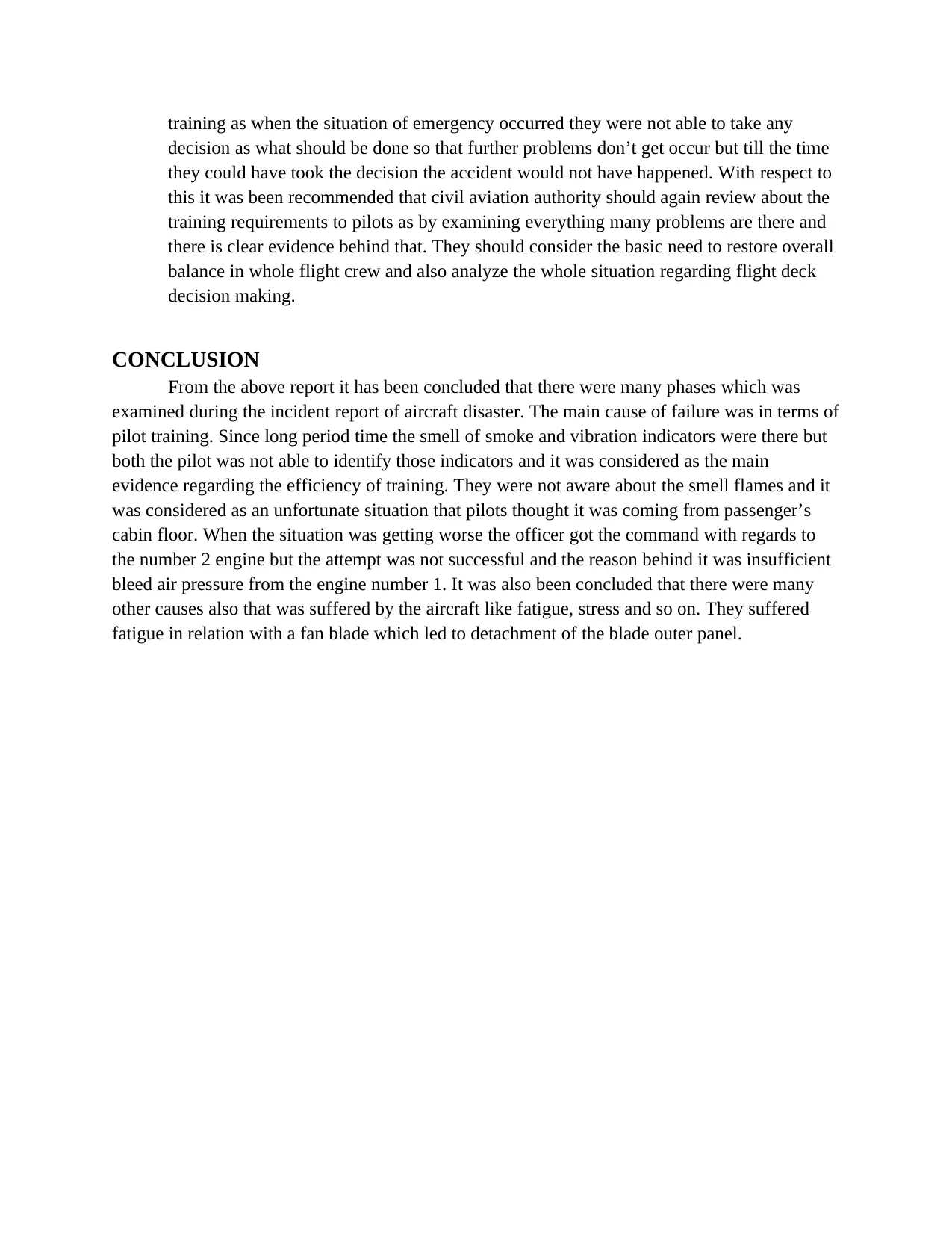
training as when the situation of emergency occurred they were not able to take any
decision as what should be done so that further problems don’t get occur but till the time
they could have took the decision the accident would not have happened. With respect to
this it was been recommended that civil aviation authority should again review about the
training requirements to pilots as by examining everything many problems are there and
there is clear evidence behind that. They should consider the basic need to restore overall
balance in whole flight crew and also analyze the whole situation regarding flight deck
decision making.
CONCLUSION
From the above report it has been concluded that there were many phases which was
examined during the incident report of aircraft disaster. The main cause of failure was in terms of
pilot training. Since long period time the smell of smoke and vibration indicators were there but
both the pilot was not able to identify those indicators and it was considered as the main
evidence regarding the efficiency of training. They were not aware about the smell flames and it
was considered as an unfortunate situation that pilots thought it was coming from passenger’s
cabin floor. When the situation was getting worse the officer got the command with regards to
the number 2 engine but the attempt was not successful and the reason behind it was insufficient
bleed air pressure from the engine number 1. It was also been concluded that there were many
other causes also that was suffered by the aircraft like fatigue, stress and so on. They suffered
fatigue in relation with a fan blade which led to detachment of the blade outer panel.
decision as what should be done so that further problems don’t get occur but till the time
they could have took the decision the accident would not have happened. With respect to
this it was been recommended that civil aviation authority should again review about the
training requirements to pilots as by examining everything many problems are there and
there is clear evidence behind that. They should consider the basic need to restore overall
balance in whole flight crew and also analyze the whole situation regarding flight deck
decision making.
CONCLUSION
From the above report it has been concluded that there were many phases which was
examined during the incident report of aircraft disaster. The main cause of failure was in terms of
pilot training. Since long period time the smell of smoke and vibration indicators were there but
both the pilot was not able to identify those indicators and it was considered as the main
evidence regarding the efficiency of training. They were not aware about the smell flames and it
was considered as an unfortunate situation that pilots thought it was coming from passenger’s
cabin floor. When the situation was getting worse the officer got the command with regards to
the number 2 engine but the attempt was not successful and the reason behind it was insufficient
bleed air pressure from the engine number 1. It was also been concluded that there were many
other causes also that was suffered by the aircraft like fatigue, stress and so on. They suffered
fatigue in relation with a fan blade which led to detachment of the blade outer panel.
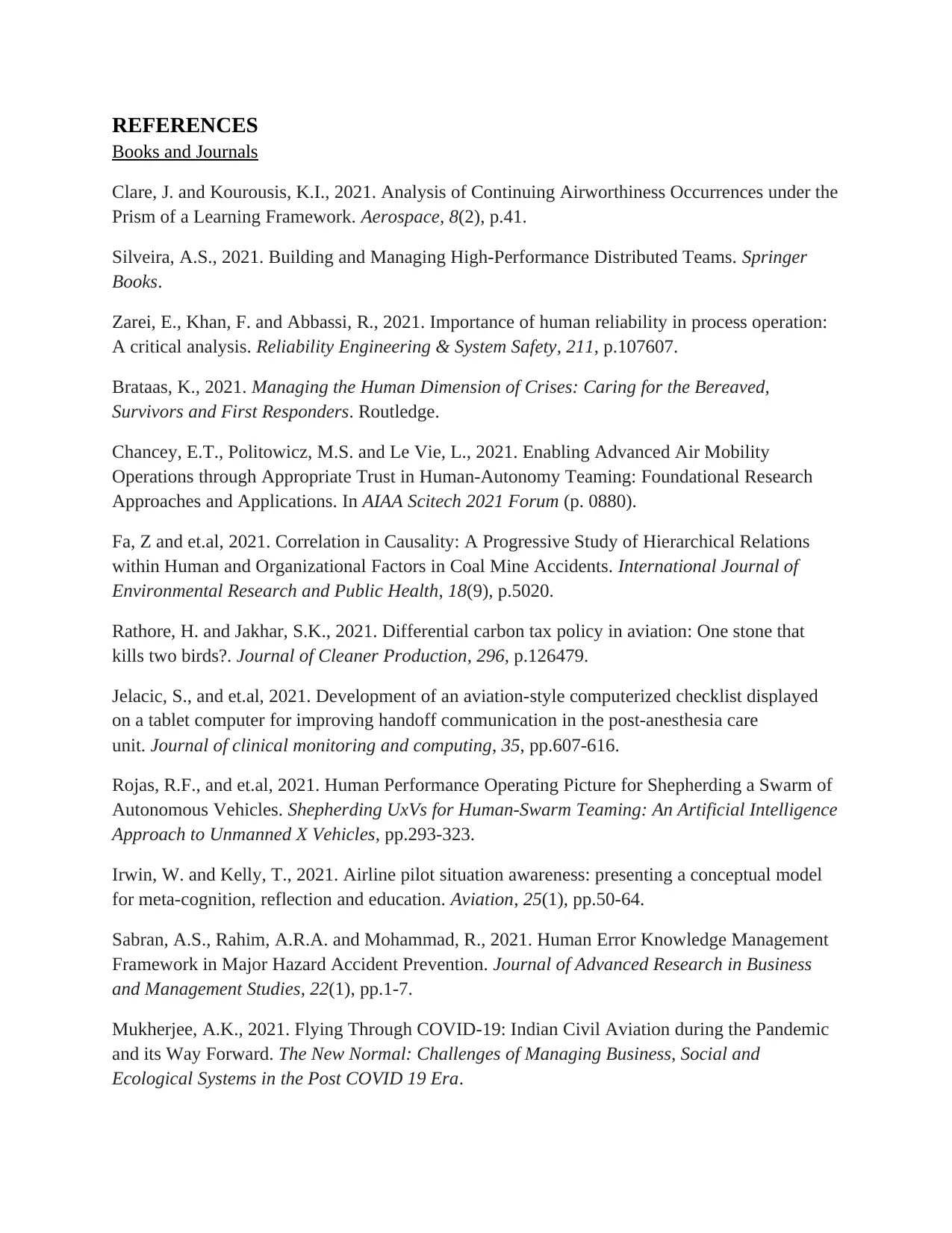
REFERENCES
Books and Journals
Clare, J. and Kourousis, K.I., 2021. Analysis of Continuing Airworthiness Occurrences under the
Prism of a Learning Framework. Aerospace, 8(2), p.41.
Silveira, A.S., 2021. Building and Managing High-Performance Distributed Teams. Springer
Books.
Zarei, E., Khan, F. and Abbassi, R., 2021. Importance of human reliability in process operation:
A critical analysis. Reliability Engineering & System Safety, 211, p.107607.
Brataas, K., 2021. Managing the Human Dimension of Crises: Caring for the Bereaved,
Survivors and First Responders. Routledge.
Chancey, E.T., Politowicz, M.S. and Le Vie, L., 2021. Enabling Advanced Air Mobility
Operations through Appropriate Trust in Human-Autonomy Teaming: Foundational Research
Approaches and Applications. In AIAA Scitech 2021 Forum (p. 0880).
Fa, Z and et.al, 2021. Correlation in Causality: A Progressive Study of Hierarchical Relations
within Human and Organizational Factors in Coal Mine Accidents. International Journal of
Environmental Research and Public Health, 18(9), p.5020.
Rathore, H. and Jakhar, S.K., 2021. Differential carbon tax policy in aviation: One stone that
kills two birds?. Journal of Cleaner Production, 296, p.126479.
Jelacic, S., and et.al, 2021. Development of an aviation-style computerized checklist displayed
on a tablet computer for improving handoff communication in the post-anesthesia care
unit. Journal of clinical monitoring and computing, 35, pp.607-616.
Rojas, R.F., and et.al, 2021. Human Performance Operating Picture for Shepherding a Swarm of
Autonomous Vehicles. Shepherding UxVs for Human-Swarm Teaming: An Artificial Intelligence
Approach to Unmanned X Vehicles, pp.293-323.
Irwin, W. and Kelly, T., 2021. Airline pilot situation awareness: presenting a conceptual model
for meta-cognition, reflection and education. Aviation, 25(1), pp.50-64.
Sabran, A.S., Rahim, A.R.A. and Mohammad, R., 2021. Human Error Knowledge Management
Framework in Major Hazard Accident Prevention. Journal of Advanced Research in Business
and Management Studies, 22(1), pp.1-7.
Mukherjee, A.K., 2021. Flying Through COVID-19: Indian Civil Aviation during the Pandemic
and its Way Forward. The New Normal: Challenges of Managing Business, Social and
Ecological Systems in the Post COVID 19 Era.
Books and Journals
Clare, J. and Kourousis, K.I., 2021. Analysis of Continuing Airworthiness Occurrences under the
Prism of a Learning Framework. Aerospace, 8(2), p.41.
Silveira, A.S., 2021. Building and Managing High-Performance Distributed Teams. Springer
Books.
Zarei, E., Khan, F. and Abbassi, R., 2021. Importance of human reliability in process operation:
A critical analysis. Reliability Engineering & System Safety, 211, p.107607.
Brataas, K., 2021. Managing the Human Dimension of Crises: Caring for the Bereaved,
Survivors and First Responders. Routledge.
Chancey, E.T., Politowicz, M.S. and Le Vie, L., 2021. Enabling Advanced Air Mobility
Operations through Appropriate Trust in Human-Autonomy Teaming: Foundational Research
Approaches and Applications. In AIAA Scitech 2021 Forum (p. 0880).
Fa, Z and et.al, 2021. Correlation in Causality: A Progressive Study of Hierarchical Relations
within Human and Organizational Factors in Coal Mine Accidents. International Journal of
Environmental Research and Public Health, 18(9), p.5020.
Rathore, H. and Jakhar, S.K., 2021. Differential carbon tax policy in aviation: One stone that
kills two birds?. Journal of Cleaner Production, 296, p.126479.
Jelacic, S., and et.al, 2021. Development of an aviation-style computerized checklist displayed
on a tablet computer for improving handoff communication in the post-anesthesia care
unit. Journal of clinical monitoring and computing, 35, pp.607-616.
Rojas, R.F., and et.al, 2021. Human Performance Operating Picture for Shepherding a Swarm of
Autonomous Vehicles. Shepherding UxVs for Human-Swarm Teaming: An Artificial Intelligence
Approach to Unmanned X Vehicles, pp.293-323.
Irwin, W. and Kelly, T., 2021. Airline pilot situation awareness: presenting a conceptual model
for meta-cognition, reflection and education. Aviation, 25(1), pp.50-64.
Sabran, A.S., Rahim, A.R.A. and Mohammad, R., 2021. Human Error Knowledge Management
Framework in Major Hazard Accident Prevention. Journal of Advanced Research in Business
and Management Studies, 22(1), pp.1-7.
Mukherjee, A.K., 2021. Flying Through COVID-19: Indian Civil Aviation during the Pandemic
and its Way Forward. The New Normal: Challenges of Managing Business, Social and
Ecological Systems in the Post COVID 19 Era.
⊘ This is a preview!⊘
Do you want full access?
Subscribe today to unlock all pages.

Trusted by 1+ million students worldwide

1 out of 10
Related Documents
Your All-in-One AI-Powered Toolkit for Academic Success.
+13062052269
info@desklib.com
Available 24*7 on WhatsApp / Email
![[object Object]](/_next/static/media/star-bottom.7253800d.svg)
Unlock your academic potential
Copyright © 2020–2025 A2Z Services. All Rights Reserved. Developed and managed by ZUCOL.




